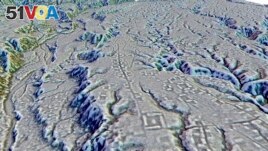21 January 2024
Archeologists have found a group of lost cities in the Amazon rainforest. The cities were home to at least 10,000 farmers around 2,000 years ago.
Stéphen Rostain first noticed the earthen mounds and buried roads in Ecuador more than twenty years ago. But at the time, "I wasn't sure how it all fit together," said Rostain. He was one of the researchers who reported on the findings in the publication Science.
Recent mapping using laser technology revealed those locations to be part of a group of settlements and connecting roads. The settlements are in the forested areas near the Andes mountains.

This LIDAR image provided by researchers in January 2024 shows complexes of rectangular platforms arranged around low squares and distributed along wide dug streets at the Kunguints site, Upano Valley in Ecuador. (Antoine Dorison, Stéphen Rostain via AP)
"It was a lost valley of cities," said Rostain, who directs investigations at France's National Center for Scientific Research. "It's incredible," he added.
The Upano people lived in the settlements between around 500 B.C. and 300 to 600 A.D. That was around the same time period as the Roman Empire in Europe, the researchers found.
Ancient people built on over 6,000 earthen mounds in an area surrounded by agricultural fields with drainage canals. The largest roads were 10 meters wide and went for 10 to 20 kilometers.
While it is difficult to estimate populations, the area was home to at least 10,000 people, and possibly about 15,000 or 30,000 at its highest point, said Antoine Dorison, a study co-writer. That is comparable to the estimated population of Roman-era London, then Britain's largest city.
"This shows a very dense occupation and an extremely complicated society," said Michael Heckenberger of the University of Florida. He was not involved in the study.
José Iriarte of the University of Exeter was also not involved in the study. He said it would have required a complex system of organized labor to build the roads and thousands of earthen mounds.
Iriarte said, "The Incas and Mayans built with stone, but people in Amazonia didn't usually have stone available to build — they built with mud."
The Amazon is often thought of as a wild area "with only small groups of people. But recent discoveries have shown us how much more complex the past really is," he added.
Scientists have recently also found evidence of complex rainforest societies that came before European contact elsewhere in the Amazon, including in Bolivia and Brazil.
"There's always been an incredible diversity of people and settlements in the Amazon, not only one way to live," said Rostain. "We're just learning more about them."
I'm John Russell.
Christina Larson reported on this story for the Associated Press. John Russell adapted it for VOA Learning English.
_____________________________________________
Words in This Story
mound – n. a small hill or pile of dirt or stones
incredible – adj. extremely good, great, or large; difficult to believe
drainage – n. the act or process of removing water or liquid from a place or thing
canal – n. a long narrow place that is filled with water and was created by people
complicated -- adj. hard to understand or explain